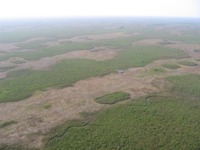Research History and Goals
A century of water management has decreased hydrologic connectivity and reduced sheetflow velocities in the central Everglades, and these changes are hypothesized to be an important contributor to degradation of the unique structure and function of the ridge and slough landscape. Important factors involved in the creation and maintenance of the ridge and slough landscape are thought to include sheet flow and its interactions with organic matter transport, nutrient retention, plant productivity and decomposition, and resulting soil buildup and/or erosion (Science Coordination Team, 2003). The hydrologic components of this problem have historically received the least attention in research (National Research Council, 2003).
One of the guiding principles of Everglades restoration is to remove flow barriers and increase sheet flow with the aim to restore degraded areas of ridge and slough. Our research addresses the hydrologic, geomorphic, and biogeochemical processes that likely will determine the effectiveness of sheetflow restoration in restoring the ridge and slough landscape. The current locations of research are in Water Conservation Area 3 at sites with remnant but relatively well preserved ridge and slough topography. Research in the 2006-2007 wet season will be expanded to include "first response" sites at locations with degraded landscape characteristics, where sheetflow restoration is expected to occur the soonest.
A principal research site was established in August 2005 in an area of remnant but well preserved ridge and slough topography in west-central Water Conservation Area 3. The site, which is referred to as WCA-3A-5, has a central dock with measurements of wind speed and direction, air temperature, and (soon) precipitation. Two wing docks on the upstream side allow access to a Cladium ridge and an adjacent Nymphaea slough, each set up for continuous measurements of water depth and water temperature profiles, specific conductivity, and sheetflow velocity at fixed depths. Complete vertical profiles of velocity are measured monthly, accompanied by monthly sampling of suspended particles and their associated size distribution and nutrient content. Porewater sampling for biogeochemical constituents also occurs monthly. During one of the monthly visits, vegetation was clipped in quadrats for biomass and volume measurements, and soil coring was conducted to determine soil physical characteristics, nutrient content, and sedimentation rate. In November 2005 tracer transport experiments were conducted in two (5-m long by 1-m wide) flumes, one located on the ridge and the other in the slough, into which solute tracers and fluorescent particle tracers (1 um) were injected at different depths of the water column. In separate experiments, measurements were made of the concentration, size-class distribution and nutrient content of suspended particles mobilized naturally by the increased velocities in the flumes. We utilize modeling as a tool to bring together all of the experimental results from across many scales to answer our broad questions. Modeling provides feedback on the relative sensitivities and uncertainties needed to prioritize the next steps in field research for predicting the effects of flow restoration on the ridge and slough landscape.
Future Directions
If ridge and slough landscape features are to be optimally restored and conserved by restoration, continued research is needed at both "remnant" and "degraded" sites, and experimental approaches must be used to test hypotheses across the gradients in hydrologic connectivity and differing degrees of topographic degradation and eutrophication that currently exist in the central Everglades. Site WCA-3A-5 is an excellent "reference" site for measuring transport conditions in remnant conditions where ridge and slough topography are relatively well preserved. It is also an excellent site to compare with sites possessing more degraded landscape topography. We plan to continue measurements and experimentation at site WCA-3A-5, emphasizing tracer experiments to characterize mobilization and transport of natural particles. We also plan to add a "first response" site, i.e. a site with substantially degraded ridge and slough topography located downstream of where substantial levee removal is expected to take place the soonest. We are currently collaborating with the South Florida Water Management District and Florida International University in the design for a 5-year, landscape-scale experiment in Water Conservation Area 3 that has the purpose of testing hydrologic and ecosystem-level responses to opening of large gaps in levees. Our experimental work will document the increased sheetflow and sediment transport processes that are expected to drive geomorphic and ecosystem-level changes over a 5-year period at a large but manageable experimental scale. The test is called the DECOMP Physical Model (DPM) to emphasize its relation to one of the key projects of the restoration referred to as DECOMPARTMENTALIZATION, which will restore sheetflow to a much larger proportion of the central Everglades.
- National Research Council, 2003, Does water flow influence Everglades landscape patterns, Washington, DC, National Academies Press, 41 p.
- Science Coordination Team, 2003, The role of flow in the Everglades ridge and slough landscape, South Florida Ecosystem Restoration Working Group, 62 p.
